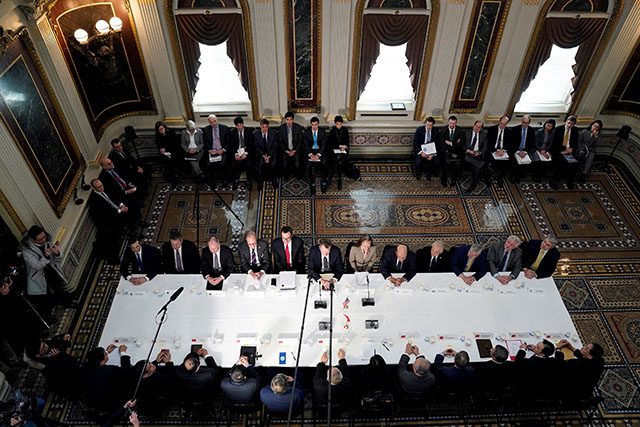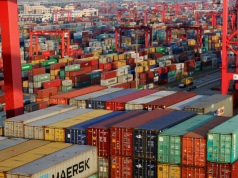
HONG KONG — U.S. President Donald Trump’s fresh threats of tariff hikes on Chinese imports this week marked a new escalation in the trade dispute between the world’s top two economies and a reversal of months of apparent progress in negotiations.
The trade war formally kicked off in July last year with tariffs on $34 billion of Chinese imports, which were followed by tariffs on an extra $16 billion in August and another $200 billion in September. China has retaliated on each of these measures with its own set of tariffs.
A subsequent threat to raise tariffs on the September list of products to 25 percent from 10 percent in March was suspended, pending trade talks.
In the latest development, Trump on Sunday said those increases could now take effect on Friday and that he would target a further $325 billion of Chinese goods “shortly”. All up, the tariffs would effectively cover all imports of Chinese goods into the United States.
Here is a look at the impact the U.S.-China trade war has had so far on the two economies and the rest of the world.
Bilateral trade
China’s customs data shows exports to the United States in March fell 47 percent from June 2018, which was the last month before the first round of tariffs kicked in. Imports from the United States in March were 17 percent lower.
Cumulatively, in the first quarter of 2019, Chinese imports fell almost a third year-on-year, while exports fell almost a tenth. In dollar terms, a decline in two-way trade of $25 billion accounts for around 0.5 percent of global trade.
Compounding the decline in imports into China was a broader weakening in domestic demand following Beijing’s campaign against financial risk taking.
The bulk of the decline in U.S. exports to China is in raw materials and food. They represent about a third of the total and have more than halved, according to Oxford Economics. But U.S. firms in other sectors, including Caterpillar and Apple, have also issued China sales warnings.
Of all Chinese exports to the United States, machinery and electrical equipment have taken the biggest hit.
Growth
Most analysts estimate direct U.S. losses so far of 0.1-0.2 percent of gross domestic product, while for China the damage could be 0.3-0.6 percent of GDP. These could grow with more, and higher tariffs.
Theses estimates, however, do not take into account how the trade war impacts investment and spending decisions by firms and consumers while domestic policy measures also muddy the waters considerably.
Partly reacting to external headwinds, the U.S. Federal Reserve has put monetary policy tightening on hold with markets now actually forecasting a rate cut this year.
China has also responded with cuts in bank reserve requirement ratios, which have boosted domestic lending to a record 5.81 trillion yuan ($862.8 billion) in the first quarter. Tax cuts are estimated to unleash an extra 2 trillion yuan, while local governments are also allowed to issue 2.15 trillion yuan of special bonds to fund infrastructure projects.
China’s economy grew at a steady 6.4 percent pace in the first quarter. In the last pre-tariff quarter, April-June 2018, the economy grew 6.7 percent, but the difference accounts for some domestically-inflicted slowdown, U.S. import front loading, domestic policy moves, and other seasonal factors.
The U.S. economy grew 3.2 percent in the first quarter, faster than the 2.9 percent in the last pre-tariff quarter.
Cross-border trade impact
S&P Global Market Intelligence’s trade data firm Panjiva says U.S. import flows are being re-routed.
U.S. imports of furniture from China fell 13.5 percent in the first quarter, which compares with a 37.2 percent increase in imports from Vietnam and a 19.3 percent rise from Taiwan. For refrigerators, imports from China fell 24.1 percent, but South Korea and Mexico each saw 32 percent jumps. Tire imports from China fell 28.6 percent, while those from Vietnam surged 141.7 percent.
A DBS analysis of Asian supply chains for U.S.-bound products shows the biggest risks in machinery and electrical equipment in South Korea, Singapore, Malaysia, the Philippines and Taiwan.
South Korea’s minerals and petrochemicals exports were also exposed, as well as Indonesia’s transportation industry, according to the DBS report.
A study by think-tank Center for Economic Policy Research showed about $165 billion in trade has been lost or redirected in order to avoid tariffs.
Market impact
Since last July, the S&P 500 index has risen 8 percent while Shanghai stocks are up 5 percent, though this is a reflection of looser-than-expected monetary policy globally and in China, as well as hopes for a trade deal this year. The yuan took a hit last year, falling 5.3 percent against the U.S. dollar, before stabilizing in 2019.
UBS Global Wealth Management CIO Mark Haefele estimates more tit-for-tat tariffs could shrink U.S. earnings by 5 percent, which, coupled with falling valuations could result in a 10-15 percent decline in U.S. equities. Chinese equities could also fall 15-20 percent, while the yuan might breach 7.0 per dollar. —By Marius Zaharia; Additional reporting by Vidya Ranganathan in Singapore; Editing by Sam Holmes






